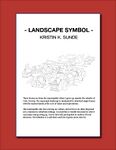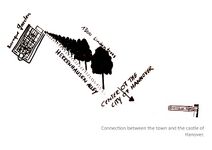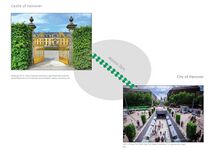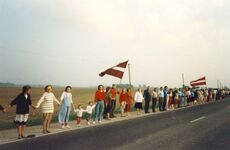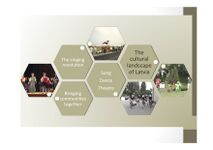LED Seminar 2016 - Landscape Symbols Reflection Group D
Landscape Symbol 1- Suburbs of Oslo, Kristin Sunde
Representations and analytical drawings
in addition to your initial visual please add two further analytical drawings of your symbol
- GroupI slide2.JPG
slide 2
- GroupI slide3.JPG
slide 3
Reflections
Please write a 250 words text reflecting on the following questions, you can also take ideas from your group members into account
- How and why did the symbols you identify appear in your landscape?
- Did their meaning change along with socio-political, economic, environmental or cultural changes in your region, or country?
- What do these symbols mean to you today? Are they meaningful to more than just one cultural group? Are they shared across cultures?
add your text here
Landscape Symbol 2- Elena Forapani
Representations and analytical drawings
in addition to your initial visual please add two further analytical drawings of your symbol
- GroupI slide1.JPG
slide 1
- GroupI slide2.JPG
slide 2
- GroupI slide3.JPG
slide 3
Reflections
Please write a 250 words text reflecting on the following questions, you can also take ideas from your group members into account
- How and why did the symbols you identify appear in your landscape?
- Did their meaning change along with socio-political, economic, environmental or cultural changes in your region, or country?
- What do these symbols mean to you today? Are they meaningful to more than just one cultural group? Are they shared across cultures?
add your text here
Landscape Symbol 3- Süntelbuche/Herrenhausen Theresia Hupfer
Representations and analytical drawings
in addition to your initial visual please add two further analytical drawings of your symbol
Reflections
Please write a 250 words text reflecting on the following questions, you can also take ideas from your group members into account
- How and why did the symbols you identify appear in your landscape?
- Did their meaning change along with socio-political, economic, environmental or cultural changes in your region, or country?
- What do these symbols mean to you today? Are they meaningful to more than just one cultural group? Are they shared across cultures?
Landscape Symbols
The Herrenhäuser alley The Herrenhäuser alley in Hanover, established in 1727, is a four-row alley of Linden. It is located in the representative baroque ‚Herrenhäuser garden‘ of Hanover and leads in a straight line with a length of approximately two kilometers. Between four rows of Linden trees three adjacent paths are located. They were recently edified for carriages, riders and pedestrians. During the foreign rule, under which the city of Hanover initially suffered from 1801 to 1813 under Prussian and later the French occupation during the Napoleonic Wars, Johann Gerhard Helmcke bought all the trees of the avenue in the beginning of the 19th century and thereby saved them from being cut down by the French troop. After the end of World War II the avenue was demarcated by barbed wire in 1946 and thus prevented the British occupying power to park its large military vehicles there. Between 1972 and 1974 most of the old trees were cut down and replanted for safety reasons. Nowadays it is a alley used by a lot of joggers, skaters and promenaders or people just relaxing on the numerous benches. As an eye-catching element at the western end of the avenue the library pavilion was built in 1817-1819. Throughout the years the alley didn‘t lose its impressive and city formative character and symbolizes an axis from the castle of Hanover to the center of the city.
Landscape Symbol 4- Village Life in Latvia, Joanna Storie
Representations and analytical drawings
in addition to your initial visual please add two further analytical drawings of your symbol
Reflections
Please write a 250 words text reflecting on the following questions, you can also take ideas from your group members into account
- How and why did the symbols you identify appear in your landscape?
- Did their meaning change along with socio-political, economic, environmental or cultural changes in your region, or country?
- What do these symbols mean to you today? Are they meaningful to more than just one cultural group? Are they shared across cultures?
add your text here
Up and down the country of Latvia in many small towns and villages you will see a stadium where local song, dance and theatre festivals are held. Song and dance festivals have been held in Latvia for many years and even Soviet repression did not silence the inhabitants, instead they had to sing Soviet patriotic songs too. The song festivals became a rallying cry to Latvians to keep them together and a subversive way of defying the Soviet authorities. The singing revolution played an influential role in regaining independence.
After independence there was freedom to sing there own traditional folk songs, dance their unique village dances and participate in theatre plays from their own past, all handed down over the years. Even though Latvia has struggled through two recessions after independence the tradition of song and dance still holds on. It is struggling as people migrate away from the villages and yet a country of around 2 million people can still produce high-class musicians and lead the world at the Choir games in 2014, where they won more gold medals than China, Russia, America and Indonesia.
This stadium is in my own village down by the river and is still used during the local village festival in July. It is amazing to see all ages participating with a repertoire from the traditional to modern. The village may have a struggling economy, but people still come together to celebrate their traditions.
Landscape Symbol 5- All about space, Esra al Najjar
Representations and analytical drawings
in addition to your initial visual please add two further analytical drawings of your symbol
- GroupI slide2.JPG
slide 2
- GroupI slide3.JPG
slide 3
Reflections
Please write a 250 words text reflecting on the following questions, you can also take ideas from your group members into account
- How and why did the symbols you identify appear in your landscape?
- Did their meaning change along with socio-political, economic, environmental or cultural changes in your region, or country?
- What do these symbols mean to you today? Are they meaningful to more than just one cultural group? Are they shared across cultures?
add your text here
Group reflection
Please add a summary of your group reflection here
